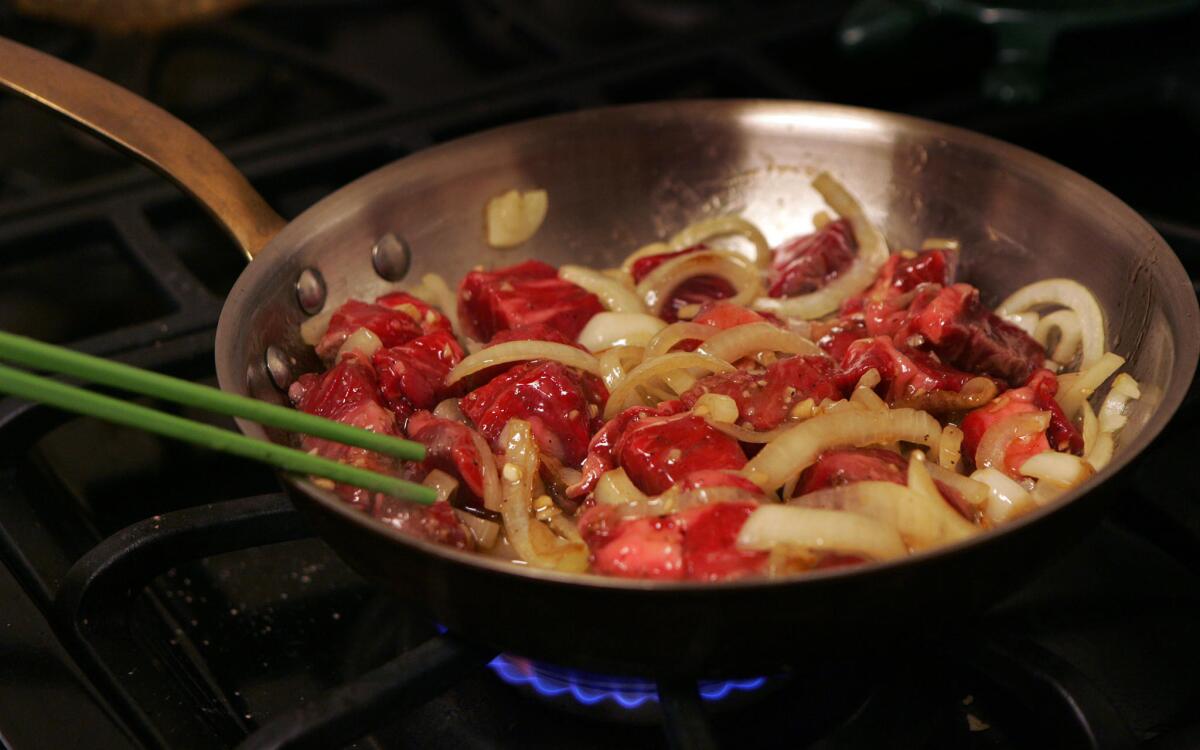Warm 'shaking beef' salad with watercress and tomatoes (Bo luc lac)

Ann Le’s parents married in 1975, a week before the end of the Vietnam War and three days before they joined relatives in two boats for an uncertain future that led from South Vietnam to a Korean refugee camp, to Minnesota and finally to Southern California.
They were among the early residents of Little Saigon in Westminster, a lively culinary destination with 200 markets, bakeries and cafes in 3 square miles, Le says. The first restaurants, she says, were just dining rooms of private homes where residents served inexpensive, family-style meals.
Growing up, Le, her brother and their parents ate Vietnamese food almost exclusively, often heading to one restaurant on Bolsa Avenue (that’s no longer in business) at the end of her parents’ long workdays. “I recall almost having the menu memorized,” she says. “Everything was family-style.”
They usually ate steamed rice, a salad platter, a meat or fish dish and a consomme. But sometimes her grandmother cooked for the family -- dishes such as braised fish, chicken salad and bun rieu, a soup with crab, tomato and noodles.
Fearing those recipes would be lost because they were not written down, Le began gathering them, finally producing “The Little Saigon Cookbook” (Globe Pequot Press), published not long before her grandmother died this year.
Le, 28, is an investment banker, not a professional cook, and she says it was a challenge to write recipes that her family and friends had only passed along orally.
“I hope people modify them,” she says. “That what’s we do at home. Everyone has their way.”
Her grandmother’s way with the sweet braised dishes called kho was among Le’s favorites. Especially braised catfish, cooked in a clay pot with lemon-lime or coconut soda and black and chile peppers. A nearly vegetarian version (except for the fish sauce) uses eggplant.
Le, who now lives in Silver Lake, returns often to see her family -- and to shop. On a recent Sunday morning, she joined the crowd at the ABC Supermarket.
The aisles were packed, the shelves precariously crowded. In the produce section, Le surveyed the banana buds, bitter melons, fresh water chestnuts, lemongrass, small white eggplants, a dozen fresh herbs. Le put Vietnamese coriander, Thai basil and mint into her cart.
Next, condiments: The huge assortment included dozens of varieties of nuoc nam, fish sauce made from salted, dried fish, usually anchovies. Le recommends those from either Phu Quoc or Phan Thiet. The fish sauce is essential for nuoc cham, the dipping sauce Le says you’ll find on every Vietnamese table; to make it, Le combines the nuoc nam with lime juice, sugar and chiles.
Among the nods to busy modern lives were little tubs of chopped frozen lemongrass -- a product Le says would surely have met her grandmother’s disapproval -- and pre-shredded green papaya.
Le looks askance at that convenience. She uses a plastic mandoline to make the pretty, almost translucent shreds that are the main ingredient in a wonderfully fragrant salad, goi du du, that also calls for Thai bird chile, Vietnamese coriander, Thai basil and fermented fish sauce. Le says the traditional salad is topped with a dried, spiced beef that’s available in the grocery stores of Little Saigon. But she likes it with cooked shrimp -- boiled or grilled.
To make a warm “shaking beef” salad (bo luc lac), Le marinates cubes of beef in nuoc nam, garlic and oyster sauce, “shaking” the container so the beef is coated. She quickly sautes plenty of sliced onion, then adds in the beef with all its marinade, stirring as it cooks. Then she spoons the rich-looking mixture onto tender watercress leaves, tops it with quartered tomatoes and serves it with steamed rice.
Asked what sort of rice she uses, Le laughs. She uses whatever brand her mother has gotten for free in a supermarket promotion -- a sign of the fierce competition among Little Saigon supermarkets.
To round out the menu, Le makes a dish that’s rarely found in restaurants: ga chien, chicken pan-fried with mint and ginger. She combines nuoc nam, ginger, garlic, Vietnamese coriander, onion and oil and marinates the chicken in it overnight. After the chicken is cooked, she cooks the marinade briefly to turn it into a sauce.
The home-style dish couldn’t be easier. The recipe for it in Le’s book calls for assorted chicken parts with the skin removed, but it’s even better made with all thighs, with the skin left on.
Cut the beef into 1-inch cubes.
Prepare the marinade in a bowl or container with a lid by combining 2 tablespoons of the oil, the fish sauce, black pepper, oyster sauce, garlic and sugar. Mix well until the sugar is dissolved, then add the beef cubes. Cover the bowl or container and shake the cubes to evenly coat the meat (or you can simply stir). Leave the cover on and let the container sit for 20 minutes on the counter.
Clean the watercress and arrange it on a large serving platter or dish.
In a large skillet, heat the remaining 3 tablespoons oil over high heat. When it is hot, add the onion. Saute for just a few minutes, then throw in the beef with its marinade and toss quickly. You need to cook for only 5 minutes over low to medium heat for the meat to be medium rare; continue tossing as it cooks. Cook it longer if you prefer.
When the meat is cooked, turn off the burner and stir in the cornstarch to thicken the sauce. Spoon onto the watercress and top with tomato wedges. Serve family style with steamed rice.
Get our Cooking newsletter.
Your roundup of inspiring recipes and kitchen tricks.
You may occasionally receive promotional content from the Los Angeles Times.
















